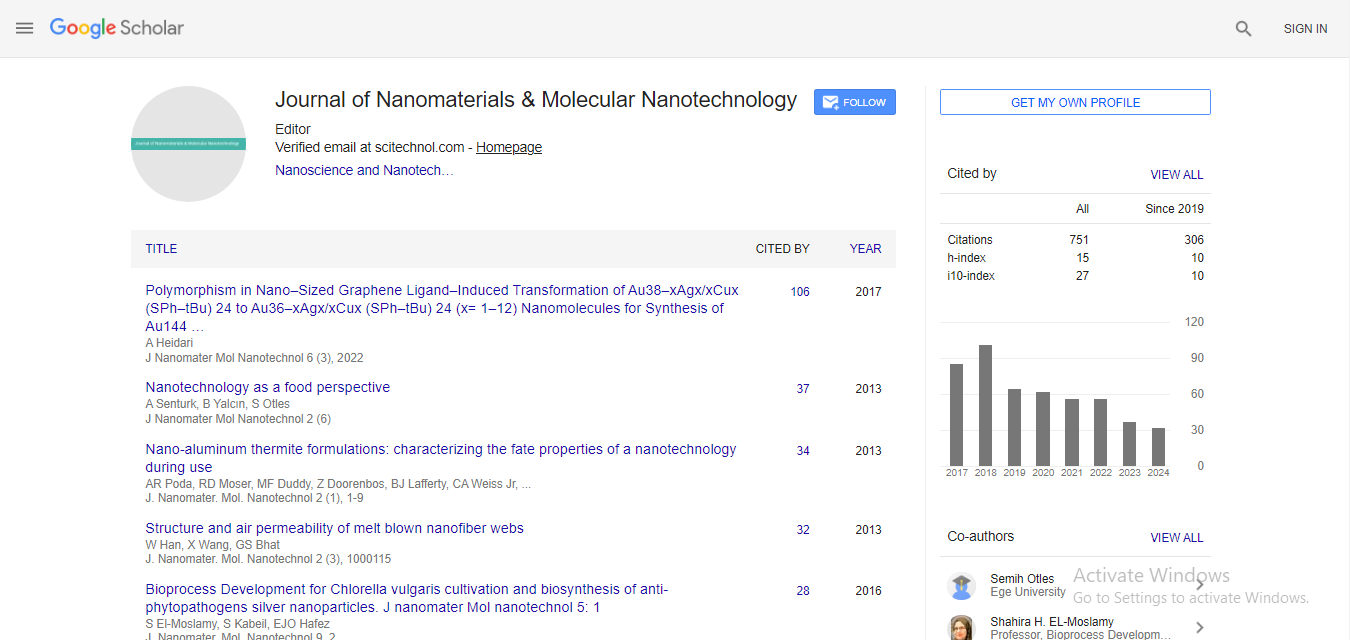Perspective, J Nanomater Mol Nanotechnol Vol: 11 Issue: 1
Self-powered Nano sensors of the Future and Limitations of Environmental Nano Sensors
Zhang Ning *
Department of Environmental Science and Engineering, Huazhong University of Science and Technology, Wuhan, China
*Corresponding author: Zhang Ning
Department of Environmental Science and Engineering, Huazhong University of Science and Technology, Wuhan, China
E-mail: ningzhang@gmail.com
Received date: 17 December, 2021, Manuscript No. JNMN-21-58130;
Editor assigned date: 20 December, 2021, PreQC No. JNMN-21-58130 (PQ);
Reviewed date: 03 January 2022, QC No. JNMN-21-58130;
Revised date: 10 January, 2022, Manuscript No. JNMN-21-58130 (R);
Published date: 17 January, 2022, DOI: 10.4172/2324-8777.2022.11(1).1000318
Citation: Ning Z (2022) Self-powered Nano Sensors of the Future and Limitations of Environmental Nano Sensors. J Nanomater Mol Nanotechnol 11:1.
Keywords: Nano Sensors
Description
Nanosensors are specific or selective in their ability to detect a number of analytes. Some nanosensors may have the ability to detect only one type of analyte, and that nanosensor is called single. Some nanosensors can detect many analytes and are known as multiplex. These functions show the selectivity and specificity of nanosensors based on their recognition elements. Many recognition elements have been used in the design of nanosensors, including antibodies, a tamers, enzymes, and some functional proteins. A tamers and antibodies are the most commonly used recognition elements in nanosensors. Nanosensors play a vital role in the field of atmospheric environmental testing. They offer important advantages over conventional methods and cater the need for portable analytical tools with features of selectivity and stability, among other aspects. The development of reliable nanosensors is projected with important realistic requirements and practical value in the area of environmental pollutant screening and monitoring. The structural properties of the sensing materials used in the fabrication of nanosensors critically define the performance of the final device. Owing to the much recent advancement in the area of material science, the modern-day nanosensors have attained much sophistication and sensitivity. They offer performance that often matches with conventional techniques. This chapter discusses nanosensors with a perspective on their advantages as detection tools as well as some of the issues that need to be addressed in order to expand their reliability and utility in practical applications.
Protein Detection
Nanosensors are gradually assuming roles in almost every aspect of human life. A number of sensors can detect the presence of hazardous materials or microorganisms in food, water, and air. These sensors are saving lives in different corners of the world. In the medical field nanosensors are having a huge impact: for example, a variety of nanosensors are being used in cancer detection, DNA and protein detection, and targeted drug delivery. Deployable sensors have found applications in homeland security. Various chemical sensors are now added to unmanned aerial vehicles to detect the presence of poisonous gas on the battlefield, to save the lives of soldiers. Various tagging systems employ RFID chips, which are also an application of nanosensors.
Traditional Techniques
Nanosensors are nanotechnology-based sensors that measure physical quantities and produce signals to detect and analyze those quantities. They are characterized by either the size of the nanosensors or their sensitivity at nanoscale. There are several types of nanosensors available on the market for different applications. Nanosensors have a wide range of applications, from space to environmental safety, biotechnology, health diagnostics, drug delivery/ screening, food safety and processing, and security. Currently, nanosensors are developed using various methods, including molecular self-assembly, top-down lithography, and bottom-up assembly. Although nanosensors exhibit different types of measurement for different things, they all share basic components. The workflow of a sensor is as follows: binding with the specific analyte, generating a signal by the interaction between biocomponents and nanosensor, and processing of the signal by utilizing the concerned metrics. Nanosensors are highly specific and selective. They can have enhanced specificity due to their functionality with chemical and biological molecules at the same scale as natural biological processes. Besides their selectivity and specificity, nanosensors are also cost effective and have rapid response, which makes them very suitable for high-throughput applications. Nanosensors are suitable for real-time monitoring, which makes them in high demand over the traditional techniques of detection, such as spectroscopy and chromatography, which are very costly and time consuming, as they may take several days to obtain results. One-dimensional nanomaterials such as nanotubes and nanowires can be utilized in nanosensors and they can behave as transducers and wires for signal transmission. Nanomaterials have a high surface area and small size, exhibiting large signal variations with the binding of analytes. The functioning of a sensor depends upon whether the material is a fluorescent or radioactive-labeled material, or a label-free material. Sensors are crucial components within every modern control system, for example in automobiles, security systems, monitoring, and diagnostics.
Fabrication of nanosensors faces several challenges, including integration with other elements of a unit, establishment of reproducible calibration methods, and separation to obtain a specific concentration of the analyte, to sidestep saturation, and to ignore drift and fouling. Though this is a new technology, there are still some issues to be addressed, such as potential nanotoxicity to biological systems, which could limit the application of nanosensors in the health industry. Nanosensors are able to measure physical changes in the body such as electrical and magnetic forces, displacement and velocity, gravitational forces, pressure, concentration/volume, and temperature, which makes them suitable for targeting particular cells at the molecular level for drug delivery and monitoring the effect of a drug on the body.
Several nanosensors and nanobiosensors have found practical roles in the agricultural sector and food industry, to quickly identify threats or pollutants in the case of suspected food poisoning or toxicity, or in combination in packaging as nanotracers to trace past records of food products, showing whether they are still within acceptable quality limits at any time. Examples are the application of nanosensors or nanobiosensors in food packaging to identify growth of
microorganisms and color changes when an edge level is approached. Nanosensors applied in queue with process control, for monitoring of storage conditions, will be useful in the near future to prevent food poisoning. Nanosensors are platforms with a characteristic dimension - nanometer in scale, and work in much the same way as a sensor they detect either minute particles or miniscule quantities of something. An analyze, sensor, transducer and detector are the components of a sensor system, with feedback from the detector to the sensor. Sensitivity, specificity and ease of execution are the main goals in designing a sensor. Our modern lives rely on sensors to allow society to run smoothly. Sensors in the road detect cars at traffic lights and adjust the flow through intersections accordingly. Sensors at shopping malls detect your presence and open doors to allow you to enter. Sensors measure the water level in your washing machine and ensure it doesn’t overflow. Like chemical nanosensors, mechanical nanosensors also tend to measure electrical changes. The nanosensors used in the MEMS systems that car airbags depend upon are monitoring changes in capacitance. These systems have a miniscule weighted shaft attached to a capacitor. The shaft bends with changes in acceleration and this is measured as changes in capacitance.
 Spanish
Spanish  Chinese
Chinese  Russian
Russian  German
German  French
French  Japanese
Japanese  Portuguese
Portuguese  Hindi
Hindi 



